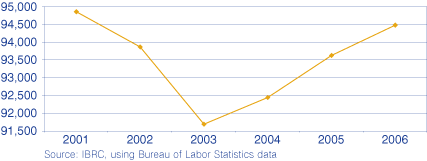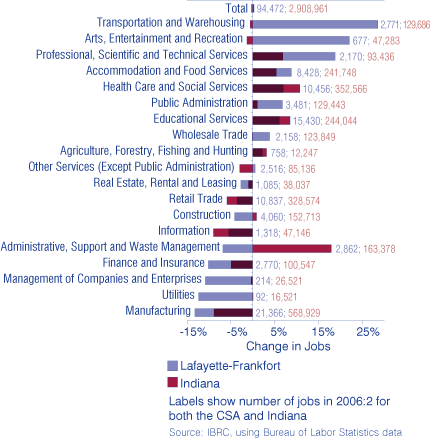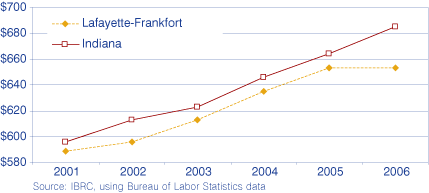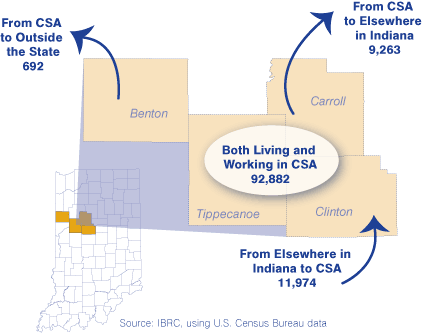The Lafayette-Frankfort CSA
This article is the fourth of seven highlighting each of Indiana's combined statistical areas (CSAs). CSAs are groupings of predefined metropolitan (metro) and/or micropolitan (micro) areas that, as the title suggests, combine these areas to “represent larger regions and reflect broader social and economic interactions.” (1)
Benton, Carroll, Clinton and Tippecanoe counties make up the Lafayette-Frankfort CSA, which comprised 3.5 percent of Indiana's population in 2005 with about 217,400 residents. The area's population has been growing over the past five years, with an average annual growth of 951 people from 2000 to 2005.
Jobs
Jobs in the Lafayette-Frankfort CSA steadily increased since 2003 and are coming closer to reaching the employment levels seen in 2001. In fact, if the area adds jobs at the same rate it has over the past three years, it will surpass the 2001 peak of 94,854 jobs (see Figure 1). Regardless of these uplifting statistics, the fact remains that the Lafayette-Frankfort CSA had 382 fewer jobs in the second quarter of 2006 than it did for the same quarter in 2001, a -0.4 percent change. Meanwhile, Indiana added 0.3 percent jobs over that time frame.
Figure 1: Jobs in the Lafayette-Frankfort CSA, 2001:2 to 2006:2

Almost half of the 20 major industries2 in the Lafayette-Frankfort CSA saw a decrease in jobs from 2001 to 2006, with the largest decline (both numerically and by percent change) attributed to the manufacturing industry (see Figure 2). At the state level, manufacturing lost the most jobs numerically and only the information sector saw a larger percent decline.
Figure 2: Percent Change in Jobs, 2001:2 to 2006:2

Three industries (manufacturing, educational services and retail trade) make up over half of total industry employment for the CSA but less than 40 percent of state jobs, simply meaning that workers in the area rely more heavily on these industries than does the rest of the state. Of these industries, educational services is where the biggest difference is seen, making up 16.3 percent of jobs in the CSA and only 8.4 percent of jobs statewide. This is not too surprising, however, given that Tippecanoe County is home to Purdue University and Ivy Tech Community College.
Wages
Average weekly wages in the Lafayette-Frankfort CSA did not see the same jump from the second quarter of 2005 to 2006 as did Indiana overall. In fact, average weekly wages in the combined statistical area leveled off completely over the last year (see Figure 3). The good news is that, over a five-year span, wages have been growing in the area, up to $653 across all industry sectors in 2006:2, an increase of $64 since 2001. Indiana increased wages over that period by $89, up to $685 per week.
Figure 3: Average Weekly Wages, 2001:2 to 2006:2

Utilities and management of companies and enterprises paid the most at the individual industry level, each paying out an average higher than $1,200 per week to workers. The state's story is similar, with the same two industries paying the most—management of companies and enterprises surpassed an average weekly wage of $1,450 in 2006. It is important to note that while these industries paid the most, they also employed the lowest percentage of total jobs in the CSA and ranked among the bottom three industries for percent of total jobs at the state level.
Commuting
There were more than 102,800 workers living in the Lafayette-Frankfort CSA according to Census 2000 data. Of those, 81.7 percent live and work in the same county and another 8.6 percent travel to one of the three other counties within the combined statistical area. Nearly 12,000 people lived outside the CSA and commuted in for work. Meanwhile, about 10,000 workers left the CSA to either work elsewhere in Indiana or outside the state (see Figure 4).
Figure 4: Commuting Patterns in the Lafayette-Frankfort CSA, 2000

Notes
- U.S. Office of Management and Budget, available at www.whitehouse.gov/omb/.
- Data for mining in the Lafayette-Frankfort CSA were not available.
Molly Manns, Associate Editor
Indiana Business Research Center, Kelley School of Business, Indiana University
